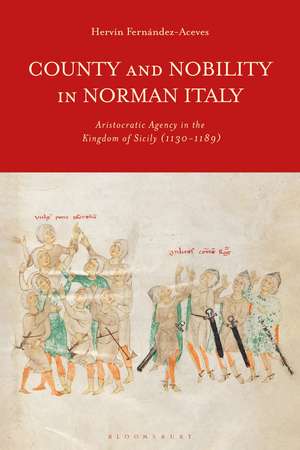County and Nobility in Norman Italy: Aristocratic Agency in the Kingdom of Sicily, 1130-1189
Autor Hervin Fernández Acevesen Limba Engleză Paperback – 23 feb 2022
| Toate formatele și edițiile | Preț | Express |
|---|---|---|
| Paperback (1) | 199.20 lei 6-8 săpt. | |
| Bloomsbury Publishing – 23 feb 2022 | 199.20 lei 6-8 săpt. | |
| Hardback (1) | 599.57 lei 6-8 săpt. | |
| Bloomsbury Publishing – 19 aug 2020 | 599.57 lei 6-8 săpt. |
Preț: 199.20 lei
Preț vechi: 258.64 lei
-23% Nou
Puncte Express: 299
Preț estimativ în valută:
38.12€ • 39.57$ • 31.79£
38.12€ • 39.57$ • 31.79£
Carte tipărită la comandă
Livrare economică 25 martie-08 aprilie
Preluare comenzi: 021 569.72.76
Specificații
ISBN-13: 9781350201651
ISBN-10: 1350201650
Pagini: 296
Dimensiuni: 156 x 234 mm
Greutate: 0.41 kg
Editura: Bloomsbury Publishing
Colecția Bloomsbury Academic
Locul publicării:London, United Kingdom
ISBN-10: 1350201650
Pagini: 296
Dimensiuni: 156 x 234 mm
Greutate: 0.41 kg
Editura: Bloomsbury Publishing
Colecția Bloomsbury Academic
Locul publicării:London, United Kingdom
Caracteristici
Provides a genealogical network which visualises relevant interfamilial relations, as well as a detailed map of the Norman Kingdom of Sicily
Notă biografică
Hervin Fernández Aceves is a Fellow of the Royal Historial Society and has published works in English and Spanish investigating aristocratic power, prosopography, digital humanities, and the socio-political history of the medieval Mediterranean. His scientific work has refined new mixed methodologies based on historical interpretation, network analysis, prosopography, and textual digitalisation. His broad research interests include cultural history, rural societies, archaeology, sociological theories, and humanities outreach. He currently works as an Honorary Researcher at the University of Lancaster, UK, Editor-in-Chief for the University of Guadalajara, Mexico, Lecturer at TecMilenio University, Mexico and content creator for podcasts, radio, and television. He was educated at the National Autonomous University of Mexico (UNAM), the Central European University, Hungary, and the University of Leeds, UK. He has been an Overseas Fellow of the National Council of Science and Technology of Mexico (CONACYT) and a Rome Awardee at the British School at Rome.
Cuprins
List of FiguresList of MapsList of Tables and DiagramsPrefaceList of Abbreviations Introduction1. The Counts of Norman Italy Before Roger II2. The New Kingdom's Nobility and the Creation of the South Italian Counties3. Leadership and Opposition of the Nobility under the Count of Loritello4. Coalition and Survival over the Ascent of Gravina5. New Spheres of Comital Action Under Margaret's Regency6. Consolidated Counties During the Reign of William II7. Beyond the County: The Counts' New Military and Political RoleConclusionsAppendix 1. A Note on the Duana BaronumAppendix 2. FiguresBibliography Index
Recenzii
This study offers a much-needed and important contribution to our understanding of the functioning of the 12th-Century Kingdom of Sicily. Its detailed analysis and prosopographies of the upper aristocracy and counties within the kingdom clearly highlights the nuances of the evolving relationship between nobility and monarchy. It will serve as a significant point of reference for further research
This impressive work is a valuable contribution to scholarship on social and political structures in Norman Italy. Through systematic and prosopographical analysis Fernández-Aceves illuminates the composition and actions, continuities and discontinuities of the Italo-Norman nobility. The complexities of the comital class and county organization challenge prevailing narratives about central authority in the Kingdom of Sicily
This impressive work is a valuable contribution to scholarship on social and political structures in Norman Italy. Through systematic and prosopographical analysis Fernández-Aceves illuminates the composition and actions, continuities and discontinuities of the Italo-Norman nobility. The complexities of the comital class and county organization challenge prevailing narratives about central authority in the Kingdom of Sicily
